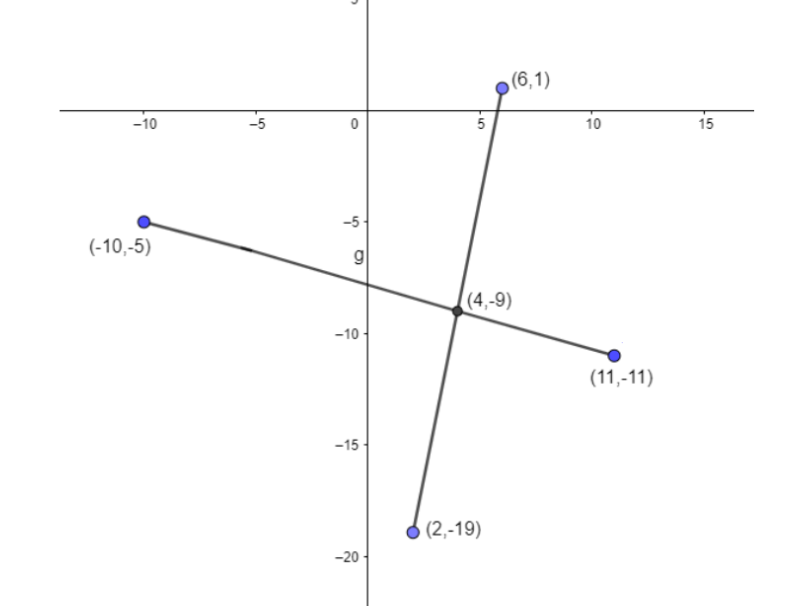Question
Question: The equation of line, which bisects the line joining two points \[(2,-19)\] and \[(6,1)\] perpendicu...
The equation of line, which bisects the line joining two points (2,−19) and (6,1) perpendicular to the line joining two points (−1,3)and (5,−1)is
A.3x−2y=30
B.2x−y−3=0
C.2x+3y=20
D.None of these
Solution
Hint : The equation bisects a line which joins two points that at points is the midpoint of the line which joins between two points like(2,−19) and (6,1). Midpoint is(2x1+x2,2y1+y2). Then, to find slope use m1m2=−1and then solve to get the answer.
Complete step-by-step answer :
Now, according to the question it is written that required line is bisect to the line AB (given in figure) which joining the two points (2,−19) and (6,1)
That means we have to find the midpoint at which the line passes
To find the midpoint point formula is given by (2x1+x2,2y1+y2)
Here, x1=2,x2=6,y1=−19,y2=1 substitute in this formula
(22+6,2−19+1)
After simplifying we get:
(4,−9)
Similarly, required line is also perpendicular to line which joining through points(−1,3)and (5,−1)
For that, we have to find the slope of the line joining through points (−1,3)and(5,−1). That is formula for slope is given by m1=x2−x1y2−y1
m1=5−(−1)−1−3
m1=5+1−1−3
By simplifying further we get:
m1=6−4=3−2
This slope of line joining through point (−1,3)and(5,−1) is m1=3−2
Now, we have to find the slope of the required line perpendicular to the line joining through point (−1,3)and(5,−1) ism1.

To find that we have to apply the formula which is given by m1m2=−1
m1=m2−1
After substituting the value of m2we get:
m1=(3−2)−1
After simplifying this we get:
m1=23
The required equation has a slope m1=23 and passes through point(4,−9).
(y−y1)=m(x−x1)
Here, x1=4and y1=−9
Substitute the value of x1=4 and y1=−9 in this equation (y−y1)=m(x−x1)
Therefore,
(y−(−9))=23×(x−4)
Simplifying this and further solving this we get:
2y+18=3x−12
After rearranging the term we get:
3x−2y−30=0
This is the required answer
So, the correct option is “option 1”.
So, the correct answer is “Option 1”.
Note : In this particular sum we have to read the question carefully because in that it is written that required line is also perpendicular to line which joining through points(−1,3)and (5,−1) that means we have to take slope of line joining through (−1,3)and (5,−1) then we have to use formula of slope which is perpendicular to that line. Don’t confuse yourself with the wording of the question. Above solution is preferred for such types of problems.
